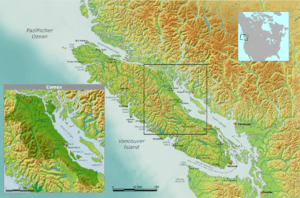K'ómoks facts for kids

Map showing traditional territory of the Island Comox; Mainland Comox not shown
|
|
| Total population | |
|---|---|
| 850 (1983) | |
| Regions with significant populations | |
| Canada (British Columbia) | |
| Languages | |
| English, Comox | |
| Religion | |
| Christianity, native | |
| Related ethnic groups | |
| Coast Salish peoples |
The K’ómoks or Comox people are an Indigenous group who have lived in British Columbia, Canada, for a very long time. Their traditional lands are around Comox on Vancouver Island and also across the Strait of Georgia on the mainland, in places like Toba Inlet and the Malaspina Peninsula.
Historically, the K'ómoks people spoke the Komox language. This language had two main dialects, or ways of speaking: Island Comox and Mainland Comox.
The Island Comox lived on Vancouver Island, mainly near Courtenay and Comox. They were once the largest and most powerful K’ómoks group. They called themselves Sathloot in their original language. Over time, another group called the Laich-kwil-tach (sometimes known as ″Southern Kwakiutl″) moved south and became very influential. The Island Comox then started using the Lik'wala dialect of the Kwak'wala language. In Kwak'wala, their name K’ómoks means "plentiful." Today, the Island Comox have strong connections with other First Nations like the Weiwaikum, Weiwaikai, and Walitsima. Many people in these groups have Sathloot ancestors. Sadly, the original Island Comox dialect and the Pentlatch language are no longer spoken; English and Lik'wala became more common.
The Mainland Comox live across the Strait of Georgia. Today, they are made up of three main groups:
- The Sliammon (Tla'amin)
- The Klahoose (whose name ƛohos means "sculpin fish")
- The Homalco (Xwemalhkwu)
K'ómoks First Nations Today
Today, the K'ómoks people are organized into different band governments, which are like local governments for First Nations. There are four main K'ómoks First Nations:
- K'ómoks First Nation (on Vancouver Island)
- Tla A'min Nation (near Powell River/Malaspina Peninsula)
- Klahoose First Nation (in the Discovery Islands)
- Homalco First Nation (in Toba Inlet)
There is also the Qualicum First Nation on Vancouver Island, which includes people with Pentlatch heritage.
K'ómoks Culture and History
The K’ómoks First Nation is made up of different tribes, including the Pentlatch, E’iksan, and Słułtxʷ. The Pentlatch people lived in the valley for thousands of years. They left behind something called the Great Midden, which is a huge pile of discarded seashells. This midden shows how much they loved shellfish, a food that is still popular on the coast today.
The E'iksan tribe moved south from the Campbell River area between 1830 and 1835. The Sałułtxʷ (K’omoks) tribe also moved south from the Quadra Island area around 1850 to 1855.
European traders started exploring the K'ómoks shores a long time ago, looking for sea otter furs. Famous explorers like Sir Francis Drake (around 1579) and Captain James Cook (in 1778) visited the coast. After them, both English and Spanish ships continued to explore the area.
K'ómoks Language: Past and Present
The original K'ómoks language is almost lost today. However, there are people in the community working hard to create a language program to bring it back to life.
Historically, at least three main dialects were spoken:
- Coast Salish Pentlatch (also called Pənƛ̕áč)
- Ayajusem (also known as Island Comox dialect or Qʼómox̣ʷs)
- Kwak'wala
Kwak'wala became the most common language in the region. It was used during the fur-trading era, in ceremonies, and when people from different groups married each other. Over time, it became a very important language.
The Pentlatch dialect is less common now. K'ómoks ancestors are said to have spoken this dialect, especially those connected to the Coast Salish side of the K'ómoks people. The last person who spoke Pentlatch fluently passed away in 1940.
The Ayajusem, or Island Comox dialect, was spoken in specific regions like Sathloot and Komokwe. The last fluent speaker of Ayajusem died in the 1990s. Both Pentlatch and Ayajusem were greatly influenced by Kwak'wala, especially in their grammar and some words.

